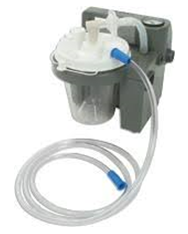- Reference Number: HEY1312/2022
- Departments:
- Last Updated: 31 July 2022
Introduction
This leaflet has been produced to give you important information for you regarding your care and treatment from the Home Ventilation Service. Most of your questions should be answered by this leaflet please keep it in a safe place as you may need to refer back to it in the future. It is not intended to replace the discussion between you and your Doctor or Specialist Nurse, but may act as a starting point for discussion. If after reading it you have any concerns or require further explanation, please discuss with a member of the Home Ventilation team.
Why is oral suction required?
A build-up of secretions may lead to discomfort and increased risk of the airway becoming blocked. Oral suction involves inserting a small plastic tube (a Yankeur suction catheter) attached to a suction machine into the mouth to remove saliva or mucus.
This may be needed if you are unable to clear secretions yourself, due to impaired swallowing reflex, impaired tongue or mouth movements and/or weak cough.
Equipment needed
- Suction Unit
- Filters/ tubing/canister
- Yankeur suction catheter
- Jug of cold water
- Personal Protective Equipment e.g. gloves, goggles, apron (for Carers use)
How to use the equipment
- Carers – wash hands and use gloves and apron as appropriate.
- Ensure suction unit/ canister/ tubing/ Yankeur are set up ready for use (see picture)
- Turn on suction machine.
- Insert Yankeur catheter into the mouth and apply suction to lower gums around the teeth. Do not apply suction further back into the mouth/ throat than the back teeth.
- The suction pressure can be adjusted if necessary (for thicker secretions)
- After suctioning insert catheter tip in the jug of water to flush all secretions from the tubing into the canister.
- Turn off suction machine after use.

Cautions
- An oral suction unit should only be used for suction from the mouth (oral cavity).
- Do not put the Yankeur suction tip to the back of the throat, or further into the mouth than you can see.
- Do not pass the Yankeur suction tip past the back teeth, to avoid stimulating gag or airway reflexes.
- Do not try to remove solid objects, food or an inhaled foreign body from the back of the mouth or throat, as this could force the object further into the airway, possibly causing an obstruction.
- Do not lay flat on your back. The respiratory physiotherapist or nurse can advise on positioning, but if you cannot sit up, you should lie on your side.
- Don’t turn the vacuum dial too high. Start off on a low setting and increase slowly, and only as required.
- Do not perform suctioning in the mouth for longer than 10 seconds at a time.
- Try to avoid bringing the Yankeur suction tip into contact with the soft tissue on the inside of the mouth, to avoid damage.
Care of equipment
- Suction a small amount of cold, clean water before and after each use. The Yankeur suction tip and tubing should be within expiry date and kept as clean as possible to prevent any build-up of bacteria that could lead to chest infections.
- Empty the canister as required.
- Follow the manufacturer’s instructions for cleaning the equipment after use.
- The suction unit battery should be regularly charged as instructed.
- Replacement consumables & equipment are obtained from NRS.
This leaflet was produced by the Respiratory Department, Hull and East Yorkshire Hospitals NHS Trust and will be reviewed in 3 years.
General Advice and Consent
Most of your questions should have been answered by this leaflet, but remember that this is only a starting point for discussion with the healthcare team.
Consent to treatment
Before any doctor, nurse or therapist examines or treats you, they must seek your consent or permission. In order to make a decision, you need to have information from health professionals about the treatment or investigation which is being offered to you. You should always ask them more questions if you do not understand or if you want more information.
The information you receive should be about your condition, the alternatives available to you, and whether it carries risks as well as the benefits. What is important is that your consent is genuine or valid. That means:
- you must be able to give your consent
- you must be given enough information to enable you to make a decision
- you must be acting under your own free will and not under the strong influence of another person
Information about you
We collect and use your information to provide you with care and treatment. As part of your care, information about you will be shared between members of a healthcare team, some of whom you may not meet. Your information may also be used to help train staff, to check the quality of our care, to manage and plan the health service, and to help with research. Wherever possible we use anonymous data.
We may pass on relevant information to other health organisations that provide you with care. All information is treated as strictly confidential and is not given to anyone who does not need it. If you have any concerns please ask your doctor, or the person caring for you.
Under the General Data Protection Regulation and the Data Protection Act 2018 we are responsible for maintaining the confidentiality of any information we hold about you. For further information visit the following page: Confidential Information about You.
If you or your carer needs information about your health and wellbeing and about your care and treatment in a different format, such as large print, braille or audio, due to disability, impairment or sensory loss, please advise a member of staff and this can be arranged.

